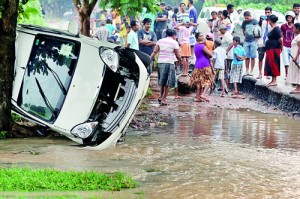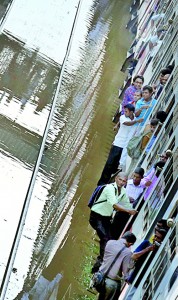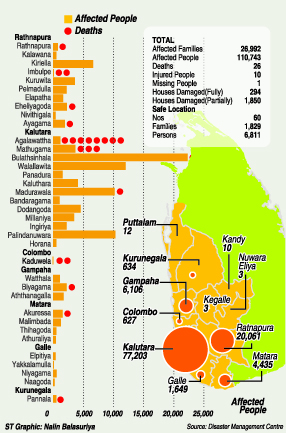News
Paying the price for roads, houses built without care
Short-sighted development has exacerbated the misery caused by the rain-floods.
The rainfall, especially in the Kalutara District, was the highest the country has received in decades. With no experience in receiving such high falls in a short period of time authorities were unprepared to deal with the situation.
According to Meteorology Department’s Deputy Director (Forecasting and Decision Support) Anusha Warnasuriya, this was the highest recorded rainfall since 2003.

A toppled vehicle in Kadawate. Pix by M.A. Pushpa Kumara
“In 2003, Deniyaya experienced 700mm rainfall, and this coupled with other natural disasters, resulted in similar loss of life. Since then this is the highest recorded,” she said.
The Director of the Irrigation Department’s hydrology unit, P. Hettiarachchi, said the short lead time before the floods left the department unable to even issue a strong warning. The unit is responsible for drainage systems and flood control around the country.
“Usually rainfall is received in the upper catchment areas and as a result the low-lying areas such as Agalawatta will only get flooded gradually. This time, however, the low-lying areas directly received unusually high rainfall in just six hours, and this was why the flooding was sudden and we were not able to issue proper warnings,” she said.

Ragama: A train ride amidst floods
She said the lack of proper drainage systems intensified the problem.
Residents in the Ratnapura and Kalutara districts blame short-sighted development programmes carried out by the authorities for the adverse situation they now face.
Asoka Upul Kumara, 39, a father of two from Adiyawala in Hedigalla, said that lack of attention to establishing proper drainage facilities when developing roads caused the flood water to stagnate in the village for days.
Hedigalla is situated on the Ratnapura-Kalawana road. The access road to some of the villages was under water.
“My house is flooded completely. Several houses in my village were inundated for a couple of days. If there is a heavy and continuing rain this area gets flooded. But the water does not stagnate for days like this. Now the situation is really bad because the authorities who made these roads failed to build a suitable drainage system.”
Deepal Adikaram, 36, another resident from the same area, shared the same view. He said the situation was worse than the severe flooding that occurred due to similar weather 10 years ago.
Although the village experiences flooding when the Kukuleganga sluice gates open the it has not previously experienced flooding of this intensity, he said adding that the authorities paid little attention to the drainage system when building the roads.
Professor Kapila Dahanayake, a geologist from University of Peradeniya, highlighted the need to take drainage flow patterns to consideration when construction projects are planned.
He said that often road construction occurred without proper consideration of the drainage flows in the area. Pointing to the incident where a car was washed away by flood water in Yakkala, he said that the car would have been caught in the drainage flow.
Dr. G. Jayathissa, a researcher attached to the Landslide Research and Risk Management Division of National Building Research Organisation (NBRO) said cutting failure was the dominant issue in most of the accidents.
Most construction in hilly areas had not followed standard precautions, he said.
The main cause of the accidents in the area were due to cutting failures, where people had cut into the hill slopes without taking proper care.
“People do not have an understanding about selecting suitable land for building or what precautionary measures to be taken when building on a slope,” he said.
Although regulations limiting such actions had been issued, implementation is slow. A Disaster Management circular states that all new constructions should go through proper assessment though the NBRO. Dr. Jayathissa says, however, that only a handful of applications are forwarded to NBRO for assessment.
“Most buildings that have been affected have never been approved,” he said.

